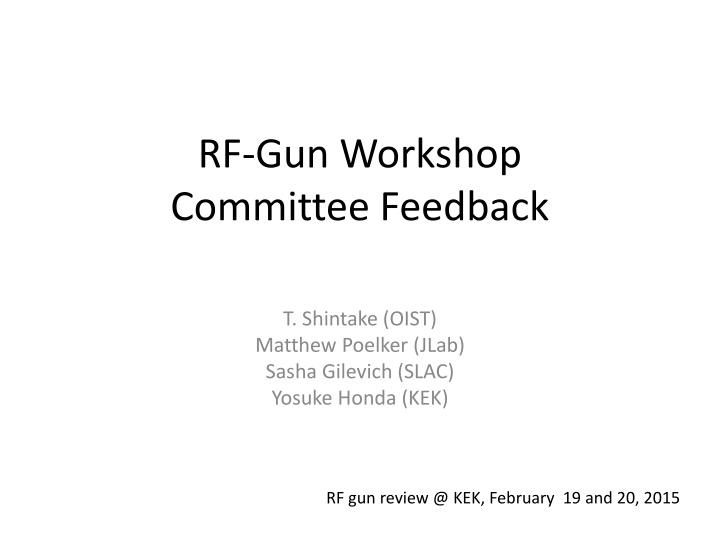
Advanced Laser Challenges and Recommendations for RF Gun Systems
Explore the challenges and recommendations for developing state-of-the-art RF gun systems, focusing on laser synchronization, amplitude noise, pulse shaping, spontaneous emission, and reliable light delivery to photocathodes. Recommendations include simplifying the laser system, utilizing diode lasers, and incorporating diagnostic tools for stability. The review committee emphasizes the importance of reliability, maintainability, and a step-by-step approach to system enhancement.
Download Presentation

Please find below an Image/Link to download the presentation.
The content on the website is provided AS IS for your information and personal use only. It may not be sold, licensed, or shared on other websites without obtaining consent from the author. If you encounter any issues during the download, it is possible that the publisher has removed the file from their server.
You are allowed to download the files provided on this website for personal or commercial use, subject to the condition that they are used lawfully. All files are the property of their respective owners.
The content on the website is provided AS IS for your information and personal use only. It may not be sold, licensed, or shared on other websites without obtaining consent from the author.
E N D
Presentation Transcript
RF-Gun Workshop Committee Feedback T. Shintake (OIST) Matthew Poelker (JLab) Sasha Gilevich (SLAC) Yosuke Honda (KEK) RF gun review @ KEK, February 19 and 20, 2015
The Review Committee Philosophy Any component integrated into the accelerator system must be Reliable, Maintainable, Reproducible Start with a simple, robust system. Improve it and add features step by step afterwards Cost is not irrelevant
The Committee Knows SuperKEKB requires state-of-the-art RF guns and drive lasers New hardware, must be designed and built, some items without precedent Resourceful group, modest size, must now finish the R&D phase, and move to production phase SuperKEKB Phase 1 operations begin January 2016, 10 months from now. Colleagues expect reliable beam soon
This came as a surprise a new beamline using the old thermionic gun and now two quasi-travelling wave guns
How to Interpret? Management is getting worried Too many ideas, at this stage of the project The gun/laser group still faces big technical challenges, and the clock is ticking
What are the laser challenges? Timing synchronization Amplitude noise Laser temporal pulse shaping Amplified spontaneous emission Two bunch generation Reliable delivery of light to photocathode The Committee can't tell how many rf gun problems are due to drive laser issues
Recommendations Develop a simple laser system without temporal pulse shaping: a simplified master oscillator, and more rugged Nd:host free-space amplifiers Consider diode laser gain-switching for your master oscillator. The MO never loses lock. Jlab can help. Add diagnostic tools to help pinpoint the origin of timing and amplitude instability. Determine where to devote your effort for the biggest return Purchase commercial components when possible. Oscillators and fiber amps, free-space amps? Do not modify the thermionic gun Yes, it s somewhat contradictory for Committee to say you have too many ideas and then suggest new things for you to try!
Energy spread reduction using temporal manipulation Energy spread of 0.1% is required for SuperKEKB synchrotron injection. 3 15nC 5nC10nC 2.5 20nC t Gaussian 2 Can you achieve your goals by shaping the electron bunch, rather than the laser pulse? E/E (%) 1.5 1 t 5nC Square 10nC 0.5 15nC 20nC 0 0 5 10 15 20 25 30 5nC electron 15nC Primary beam for positron production FWHM (ps) When the charge distribution is uniform in a cylinder, the energy spread of the bunch is lower than the result of Gaussian charge distribution. For the laser source, the pulse width should be reshaped to rectangle structure.
Two bunch generation By eliminating pulse shaping task from laser system, does it become easier to generate two bunches? Replace Yb:disk with rugged Nd:host amplifier material: less thermal lensing, more uniform gain applied to both pulses?
Preparing for Production Running Improve the environment for laser systems: temperature, vibration, wind Consider normal incidence laser illumination of the cathode. Or, effective normal incidence, using grating or prism Implement a laser imaging system to minimize pointing instability, learn from LCLS Shutter in front of gun + virtual cathode diagnostics to set laser spot size at the photocathode, to avoid accidental tight focus and damage Harmonic crystals need to be carefully installed: temperature, vibration. Transporting UV light not trivial
How to avoid damaging fibers? Can your colleagues at KEK cERL help you with this problem? IMPROVEMENT This makes the electric field discharge limit much higher. Heat diffusion becomes much better. AR coating will eliminate reflection from output side, stable operation. Careful alignment will be important.
Photocathode and RF-gun Committee congratulates the team for discovery of IrCe phptocathode Committee congratulates the team for the invention of quasi-traveling wave side coupled RF-gun, which will preserve emittance from the cathode to relativistic energy Drive laser issues appear to dominate the group s attention, making it difficult to work on gun and photocathode issues Review Committee will provide a detailed summary report. We intend to evaluate SuperKEKB laser specifications against other existing laser systems
